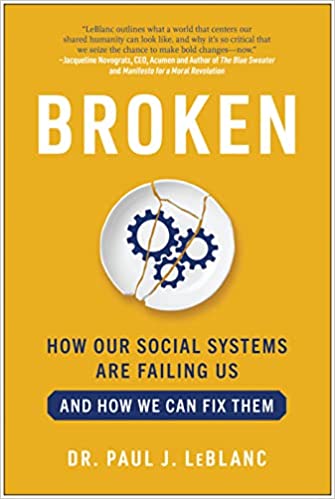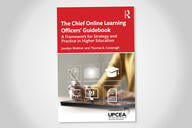You have /5 articles left.
Sign up for a free account or log in.
 Broken: How Our Social Systems Are Failing Us and How We Can Fix Them by Paul LeBlanc
Broken: How Our Social Systems Are Failing Us and How We Can Fix Them by Paul LeBlanc
Published in September 2022
The BHAG (Big Hairy Audacious Goal) for higher education in the 21st century is achieving scale within a relationship-centric approach to teaching and learning. Scale is likely the only viable path to bending the postsecondary cost curve. It is only through scale that higher education will become both accessible and affordable to all those shut out of attaining a university education.
Southern New Hampshire University president Paul LeBlanc’s new book, Broken, is about scale. LeBlanc is determined to take what he has learned about scale from SNHU and apply those lessons to the broader higher education ecosystem and beyond.
If any university president is well placed to think about scale, it is LeBlanc. SNHU is the largest university in the U.S., enrolling around 178,000 students. Of these, 175,000 are fully online, with about 3,000 residential students living and learning on SNHU’s Manchester, N.H., campus.
In the case of SNHU, the goal to scale to 175,000 students was not driven by maximizing profits. Instead, the more students SNHU serves, the more the university can drive down the cost for each student. The result is that a fully online master’s degree from SNHU, with books and supplies, has a sticker price of under $25,000. In Broken, LeBlanc partly explains how SNHU achieves this affordable price tag.
I say “partly” because unpacking how SNHU works is only part of what LeBlanc is after in Broken. His aim in Broken is to generalize the practices of SNHU to enable other universities, as well as leaders in adjacent industries (health care and criminal justice in particular), to rethink how their organization’s scale.
From the perspective of someone who works within higher education and who is very interested in figuring out how to scale educational offerings while maintaining a relationship-centric approach, I wanted more on SNHU. I can understand LeBlanc’s instinct not to have Broken read as a book-length advertisement for SNHU. And in the book, LeBlanc is honest about his institution’s failures and successes.
From what LeBlanc writes about SNHU and from what I understand about its operations, here is how I think his university designs for quality at scale. The fully online programs at SNHU differ from the residential education that the university offers to traditional-aged undergraduates in several important attributes.
SNHU’s online education is unbundled in that the curriculum and course designs are done by nonfaculty educators, standardized and closely aligned with employer demands. SNHU’s online faculty, who are not tenure track but rather receive long-term contracts, teach a curriculum and a set of digital materials that they did not design. Instead, the faculty focuses on instruction. Faculty members are then augmented by coaches who work directly with the students to help them navigate school, work and life challenges.
The SNHU humans who care for students are further augmented by data-driven early warning systems and learner analytics that identify students who are at risk of not succeeding, enabling the coaches, faculty and other student support professionals to intervene. SNHU being a nonprofit, the savings involved in reducing the marginal cost to enroll each additional fully online student (most of who work full-time and care for family) can be plowed back into improving the quality of the degrees and keeping costs low.
The idea that universities can scale without sacrificing close connections between educators and learners emerges from LeBlanc’s biography. Broken is a deeply personal book, and LeBlanc takes the time to share his working-class background and experience as an immigrant and first-generation college student.
LeBlanc’s leadership of SNHU is deeply values-driven. He insists that every decision be made through the lens of what will most benefit students. Through building a workplace culture at SNHU based on respect and caring, the goal is to have the students who enroll at the university feel cared for, even as the number of students served continues to grow.
Reading Broken left me with two questions. First, I wonder if LeBlanc’s ideas about how universities might leverage online learning to expand the number of students served without sacrificing educational quality can realistically be applied across the postsecondary ecosystem. Second, I’m curious to see if reading Broken might persuade a range of university leaders that scale and quality do not need to be in opposition.
I can’t speak for industries beyond higher education; perhaps readers in health care and other human service–based organizations will read Broken and be similarly inspired. Reading Broken has re-energized my curiosity about how scale with intimacy might be approached within higher education.
For many years, Paul LeBlanc has been a higher education leader whom I have admired, looked up to and learned from. The conversations I’ve had with LeBlanc are among my most cherished. Broken is written in such a conversational and often vulnerable voice that even those who do not know LeBlanc personally will feel like they do after finishing the book.
What are you reading?
Note: For more on the book, please read Matt Reed’s excellent discussions of LeBlanc’s Broken here and here.




